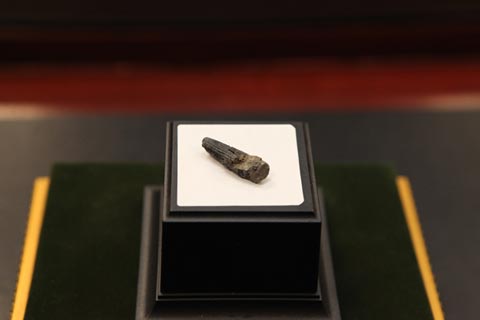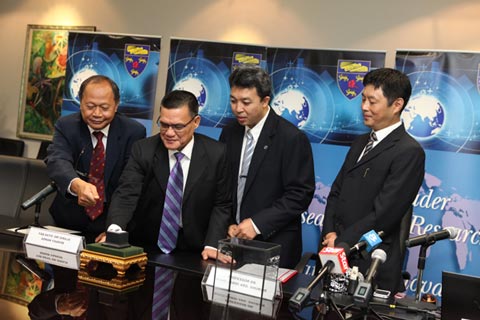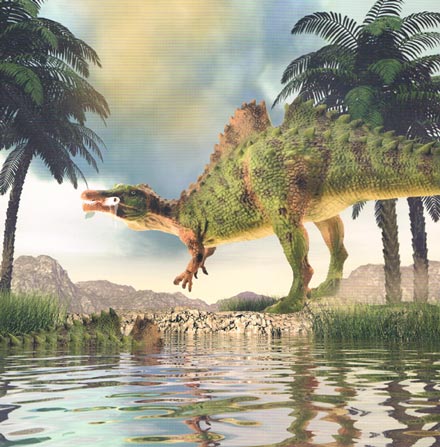Malaysia’s First Dinosaur Discovery – Potential Spinosaurid
On a scale of dinosaur discoveries a few isolated and worn teeth are not necessarily going to set the world of palaeontology alight but for the team of Malayan and Japanese researchers, the fragmentary fossils discovered at a secret location, deep in the heart of rural Pahang have finally put Malaysia on the map when it comes to the Dinosauria.
Malaysia’s First Dinosaur
Scientists from the University of Malaya working in collaboration with researchers from the Waseda and Kumamoto universities (Japan) have evidence of a potential spinosaur from Cretaceous aged deposits. These are the first known dinosaur fossils to have been found in Malaysia.
Much of the central area of Pahang has exposed outcrops of Mesozoic aged strata, particularly sediments dating from the Cretaceous, however, this is the first time that evidence of dinosaurs having once roamed the peninsular of Malaysia has been found. Field expeditions had been mapping likely sites since September 2012 and in a press conference, the excited scientists confirmed that they had indeed found dinosaur fossils and in all likelihood their discovery represents a new species of theropod dinosaur belonging to the Spinosauridae.
Commenting on the fossil finds, lead researcher Dr Masatoshi Sone stated:
“We have started our collaboration and carried out field expeditions to search for potential dinosaur deposits. Recently, we have successfully confirmed the presence of dinosaur remains [fossilised teeth] in Pahang.”
Fossil sample number UM10575 is one of the team’s most spectacular finds, measuring just under an inch in length (23 mm) and 10 mm wide. The shape and serrations have led the team to suggest that this tooth is that of a carnivorous dinosaur that specialised in hunting and eating fish.
Spinosaurid Fossils
A number of spinosaur fossil discoveries have been made from Australasia in recent years. The spinosaurid known as Ichthyovenator (Ichthyovenator laosensis) was discovered in Laos in 2010, in Savannakhet Province, there have also been reports of potential spinosaur fossil material being found in Australia.
To read more about the potential Australian Spinosaur: Tiny Vertebra Re-Writes the History of Australian Dinosaurs.
It was Professor Ren Hirayama (Waseda University, Tokyo), who was given the task of identifying the creature that the teeth probably belonged to. He describes specimen number UM10575 as having distinct carinae (front and rear edges), typical of the teeth from a spinosaur. In addition, there are well-marked coarse ridges running down the tooth and the surface bears micro-ornamentation which when viewed under the microscope are characteristic of spinosaurids.
Picture credit: University of Malaya
Dinosaur Tooth Fossil
It is very likely that there are substantial vertebrate fossil deposits in Malaysia and the Japanese/Malaysian team are confident that dinosaur bones will soon be discovered. However, they are keeping the exact location of the teeth discovery under wraps. There is a large black market in dinosaur fossils and a number of important sites in Thailand, Mongolia and Laos have been plundered as unscrupulous fossil dealers cash in on the high prices that such fossils can fetch.
The scientists expressed the need for the authorities to protect such areas so that private fossil collectors and smugglers can be deterred. As more fossils are found, it is hoped that Malaysia will one day have its very own Natural History Museum, perhaps in a building close to the University of Malaya in Kuala Lumpur.
Scientists Announce the Fossil Discovery
Picture credit: University of Malaya
Left to right: Dean of Faculty of Science, Professor Dato Dr Mohd Sofian Azirun; Adnan, Deputy Vice-Chancellor (Academic & International), Professor Dr Mohd Hamdi Abd. Shukor and Dr Masatoshi at the press conference where the fossil was unveiled.
Without any further body fossils it is not possible to reconstruct and image of what the dinosaur might have looked like. It’s size cannot be estimated either, however, if there has been evidence of a large predator found, then it is very likely that other vertebrate fossils will be discovered. Certainly, there will be other reptiles, crocodiles and turtles, as these creatures are often found in the lacustrine or estuarine deposits associated with spinosaur fossil discoveries. In addition, if the habitat supported one large, specialised predator such as a member of the Spinosauridae it is very likely that other dinosaurs and flying reptiles were present.
Everything Dinosaur team members expect to hear more about dinosaur discoveries from this part of the world in the next few months.
An Illustration of the Spinosaur from Laos (Ichthyovenator)
Picture credit: Everything Dinosaur
For models and replicas of Asian theropod dinosaurs and other prehistoric animals: CollectA Prehistoric Life Models.








I have a fossil ! Look like a dinosaur leg born !